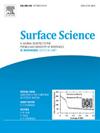Influence of Si buffer layer on the crystal quality of SiGe films in Ge/Si/SiGe heterostructures: A molecular dynamics investigation
IF 1.8
4区 化学
Q3 CHEMISTRY, PHYSICAL
引用次数: 0
Abstract
SiGe materials have become a research hotspot due to their important applications in semiconductor devices, especially in optoelectronic and high-speed electronic devices. In this study, based on molecular dynamics simulations, the influence of the Si buffer layer on the quality of films in Ge/Si/SiGe heterostructures is investigated. By simulating the growth process of the Ge/Si/SiGe heterostructure, a deposition model based on Ge(100) substrates is established. Inspired by the concept of reverse gradient buffer layers, Si buffer layers are directly grown on Ge substrates, followed by the deposition of SiGe films. This study primarily investigates the effects of the growth temperature and deposition thickness of the Si buffer layer on the quality of SiGe films. Based on the deposition parameters identified as suitable under the current simulation conditions (620 °C, 9.7 nm), the influence of the buffer layer on SiGe films with varying Ge compositions is further analyzed. The results show that the dislocations and stacking faults formed in the Si buffer layer effectively relieve the stress caused by lattice mismatch, thus improving the crystal quality of the subsequent SiGe films. This study provides theoretical insights into the Ge/Si/SiGe heterostructure film growth process, which helps enhance the quality of SiGe films and expands their applications in semiconductor devices.

Si缓冲层对Ge/Si/SiGe异质结构中SiGe薄膜晶体质量的影响:分子动力学研究
由于SiGe材料在半导体器件特别是光电子和高速电子器件中的重要应用,已成为研究热点。本研究基于分子动力学模拟,研究了Si缓冲层对Ge/Si/SiGe异质结构薄膜质量的影响。通过模拟Ge/Si/SiGe异质结构的生长过程,建立了基于Ge(100)衬底的沉积模型。受逆梯度缓冲层概念的启发,直接在Ge衬底上生长Si缓冲层,然后沉积SiGe薄膜。本研究主要考察了生长温度和硅缓冲层沉积厚度对SiGe薄膜质量的影响。在当前模拟条件(620°C, 9.7 nm)下确定合适的沉积参数的基础上,进一步分析了缓冲层对不同Ge组成SiGe薄膜的影响。结果表明,在Si缓冲层中形成的位错和层错有效地缓解了晶格错配引起的应力,从而提高了后续SiGe薄膜的晶体质量。本研究为Ge/Si/SiGe异质结构薄膜的生长过程提供了理论见解,有助于提高SiGe薄膜的质量,扩大其在半导体器件中的应用。
本文章由计算机程序翻译,如有差异,请以英文原文为准。
求助全文
约1分钟内获得全文
求助全文
来源期刊

Surface Science
化学-物理:凝聚态物理
CiteScore
3.30
自引率
5.30%
发文量
137
审稿时长
25 days
期刊介绍:
Surface Science is devoted to elucidating the fundamental aspects of chemistry and physics occurring at a wide range of surfaces and interfaces and to disseminating this knowledge fast. The journal welcomes a broad spectrum of topics, including but not limited to:
• model systems (e.g. in Ultra High Vacuum) under well-controlled reactive conditions
• nanoscale science and engineering, including manipulation of matter at the atomic/molecular scale and assembly phenomena
• reactivity of surfaces as related to various applied areas including heterogeneous catalysis, chemistry at electrified interfaces, and semiconductors functionalization
• phenomena at interfaces relevant to energy storage and conversion, and fuels production and utilization
• surface reactivity for environmental protection and pollution remediation
• interactions at surfaces of soft matter, including polymers and biomaterials.
Both experimental and theoretical work, including modeling, is within the scope of the journal. Work published in Surface Science reaches a wide readership, from chemistry and physics to biology and materials science and engineering, providing an excellent forum for cross-fertilization of ideas and broad dissemination of scientific discoveries.
 求助内容:
求助内容: 应助结果提醒方式:
应助结果提醒方式:


